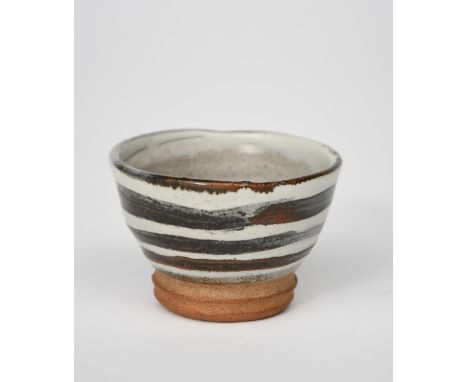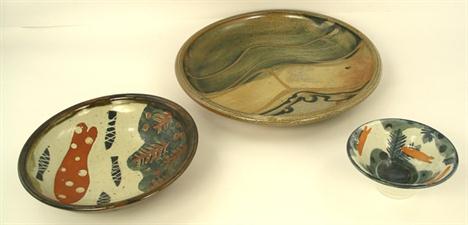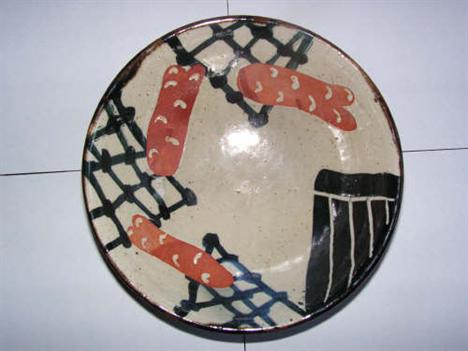We found 177 price guide item(s) matching your search
There are 177 lots that match your search criteria. Subscribe now to get instant access to the full price guide service.
Click here to subscribe- List
- Grid
-
177 item(s)/page
‡ William Staite Murray (1881-1962) a stoneware tea bowl made for Bernard Rackham, dated 1930, footed form, painted with a simple flower design in rust on a pale oatmeal ground, the rim incised Bernard Rackham his Tea Bowl 1930, impressed seal mark, 8cm. diam. Catalogue notes Bernard Rackham (1876-1964) was keeper in charge of the Ceramics Department at the Victoria & Albert museum (from 1914 to 1938) and a supporter of Staite Murray's work which he reviewed in The Studio Yearbook in 1917. Exhibited 30 Pots, Woolley and Wallis, 2019, catalogue number 24.
‡ William Staite Murray (1881-1962) a stoneware tea bowl made for Ernest Marsh, dated 1930, footed form, the flaring bowl painted with simple flower stems and a band in iron, the band then scratched Ernest Marsh His Tea Bowl 1930, on oatmeal ground impressed seal mark, paper label to base, 8.5cm. diam. Provenance Contemporary Ceramics, Bonhams, 19th October 2004 lot 4 Exhibited 30 Pots Woolley and Wallis, 2019 catalogue number 12 Literature Sarah Riddick Pioneer Studio Pottery The MIlner White Collection, Lund Humphries, page 91 for a comparable tea bowl made for Milner White.
WILLIAM STAITE MURRAY (1881-1962); a squat stoneware vase with pronounced collar covered in olive green glaze with brushed copper decoration, impressed M mark, height 13cm. (D)Additional InformationAppears good with no obvious signs of faults, damage or restoration. This lot qualifies for Artist Resale Rights. For further information, please visit http://www.dacs.org.uk
Constance E Dunn (nee Wade): A Stoneware Vase, oatmeal glaze with tenmoku brush strokes and rim, impressed W seal mark, 16cm Exhibited as Wade until her marriage in 1928. Trained at Cambridge School of Art, 1921-4, Royal College of Art, 1924-7. Pupil of William Staite Murray. Same design bowl in the V&A's collection. Provenance: From the collection of the late Elizabeth Gwendolen Mullins OBE. Elizabeth was a weaver of rugs in natural dyes, and crafted from her centre Graffham Weavers, West Sussex. Artists' Resale Rights/Droit de Suite may apply to this lot, please refer to Terms of Business
A large archive compiled by George Twyman relating to the Martin Brothers, including a magic lantern projector with case by Perken Son & Co Ltd, used by Ernest Marsh for illuminated lectures, The Martin Brothers Potters by Malcolm Haslam, Gorgeously Grotesque Worthing Museum and Art Gallery catalogue, Martin Brothers Pottery Exhibition catalogue, Richard Dennis Gallery, 1978, a catalogue of the Frank Knight collection of Martinware and a large collection of photographs relating to the Martin Brothers, William Staite Murray and their contemporaries including ephemera from Ernest Marsh, (a lot) Provenance The George Twyman Collection of Martin Ware
William Staite Murray (British 1881-1962), a vase, ash colour with brown brush marks to shoulder, impressed mark, 17cm high CONDITION REPORT: Good condition, no damages or repairsARR Artist's Resale Right may apply to the sale of this lot, incurring an additional fee. For further information please ask Chorley's or visit www.dacs.org.uk
•WINIFRED NICHOLSON (1893-1981) POPPIES Oil on canvas 49.5 x 49.5cm. Exhibited: London, Messrs Ernest, Brown and Phillips at The Leicester Galleries, 1930 (very faintly inscribed label on stretcher), the artist's first solo exhibition there Provenance: Bought at the above exhibition by Lady Horlick, thence by descent * Jane, Lady Horlick, was the daughter of Colonel Cunliffe Martin and was the first wife of Sir Ernest Burford Horlick, 2nd Bt. (1880-1934). She married secondly, in 1931, the diplomat Sir Francis Charles Oppenheimer (1870-1961) "I like painting flowers," Nicholson once stated. "I have tried to paint many things in many different ways, but my paintbrush always gives a tremor of pleasure when I let it paint a flower … to me they are the secret of the cosmos." The simple format of an otherwise unadorned table top appealed greatly to Nicholson and the uncluttered layout injected her work with confidence and an effortless panache. She would work on a number of variations before settling upon a final composition, all the while showing an unerring eye for supreme balance that had drawn her to Piet Mondrian's art (a 1932 example of whose work hung in pride of place in her front kitchen at Bankshead). Paul George Konody reviewed the exhibition in which this picture was shown and identified a subtlety in the artist's blend of form, space and colour: 'Elegance of arabesque and loveliness of colour and surface quality help towards making her pictures the gems of wall decoration which they undoubtedly are. She is not content with the two-dimensional disposition of her material, and is invariably bent upon the conquest of the third dimension, although her indication of special relations is too subtle to become immediately obvious to the spectator. The refinement of her colour harmonies baffles description.' (P.G. Konody, 'Berthe Morisot and Winifred Nicholson', Observer, 30th March 1930) Similarly, Jim Ede, a friend of the artist and the founder of Kettle's Yard in Cambridge, noted Nicholson's instinctive response to the age-old theme of still life. He admired how she interpreted the depiction of nature with an almost spiritual intensity: 'She paints a pot of flowers and in it you feel the laws of universal birth - it isn't just these flowers growing - it is the whole life of nature … She obtains a freshness in her painting, and for colour, I know of no one who interprets so truthfully the pure clarity of flowers themselves. There is about it all an ease and simplicity, an apparent effortlessness, inevitable as the moving of clouds in a blue sky; and this is because her work is a thing felt before it is seen.' (Jim Ede, quoted in Jovan Nicholson (ed.), Art and Life, Ben Nicholson, Winifred Nicholson, Christopher Wood, Alfred Wallis, William Staite Murray, 1920-1931, London, 2013, p.83). A very high resolution image of this lot can be viewed on our website: www.lawrences.co.uk
[§] ROBERT J WASHINGTON (BRITISH, 1913-1997)VASE, 1981 impressed artist's and date mark, stoneware painted and glazed with nude figures46.5cm high (18.25in high)Note:Robert Washington was a significant figure in the British studio ceramics movements, a key follower of William Staite Murray and his school of thought. They believed in distancing their work from craft associations arguing that pots should be seen as fine art.Washington taught at the Derby College of Art at either side of World War II, before becoming principal of Dewsbury and then Margate Schools of Art. His work showed the clear influence of Murray, but with his own interpretation of the figure.
Margaret Enid Rey (British, 1911-2010) a glazed stoneware vase with blue interior, circa 1937, impressed potter`s monogram, 8.5cm high A noted pupil of William Staite Murray, Margaret Rey shared her studio with Sam Haile after she left the Royal College of Art (1927-1930) and was given a large solo exhibition at the Brygos Gallery in 1938.
A rare Doulton Lambeth art pottery vase by A.G Hopkins dated 1927, of baluster form and with partial experimental blue glaze, signed, 7cm high Born in Lambeth. He was the third generation of a family of potters and was the son of Alfred Hopkins (born c.1865 in Lambeth), a potter and pottery foreman probably at the Doulton Factory. His brother was the potter, Henry Loveday Hopkins (born c.1886 in Lambeth). Alfred George worked as a plasterer in the pottery between c.1901-11. He established himself as a studio potter before 1915 and worked with his brother Henry Loveday as 'Hopkins Brothers' from 208 Lambeth Road and in the 1920s from the Old Lambeth Pottery, 149 Lower Kennington Lane. Their work was collected (c.1926-9) by Sydney K. Greenslade, curator of the Arts and Crafts Museum at the University of Aberystwyth (there are thirty-two items in the collection, reference below). The Hopkins Brothers also modelled animals and figures and marketed materials for other potters. Alfred's work was exhibited at the Fine Art Society in 1927 and 1928. He also organised a show of his work at the Old Lambeth Pottery in 1929 which was compared favourably to pottery by William Staite Murray in a review in 'The Times' (23 November 1929). Around 1932 Alfred (and possibly his brother) relocated to Broadstairs, Kent and established the Stone Pottery. He died in Broadstairs, Kent.
William Staite Murray, a woodblock print on paper of songbirds on a branch, signed and dated in red pencil 1933, 17cm², together with another print of a farmyard scene, signed, 17 x 19cm. Condition Report: Overall condition good, slight foxing on larger picture to mount, have not been examined out of frame (unable to remove).
WILLIAM STAITE MURRAY (1881-1962); an early stoneware shouldered vase covered in mottled olive green glaze with tenmoku spots, incised signature, height 13cm (D). CONDITION REPORT: Murray has ground off glaze at base resulting in some flaking, otherwise appears good with no further obvious signs of faults, damage or restoration, diameter approximately 13cm.This lot qualifies for Artist Resale Rights. For further information, please visit http://www.dacs.org.
‡ William Staite Murray (1881-1962) a footed stoneware bowl, covered with a deep iron rich glaze to the foot, impressed pentagon seal, 17.5cm. diam. Provenance Contemporary Ceramics, Phillips, London 25th September 2001, lot no.63. Exhibited British Studio Pottery The Collection of a Discerning Academic, Monnow Valley Arts, 26th September - 8th November 2009, catalogue number 3 (illustrated page 2).
‡ William Staite Murray (1881-1962) Winter a stoneware bowl on pronounced foot, the flaring bowl glazed mottled olive green and white, the rim with tenmoku, impressed seal mark to side of foot rim, painted SKSID 62, 16cm. diam. 11.5cm. high Provenance Contemporary Ceramics, Bonhams, London 15th June 1989 lot 2. Exhibited 20th Century British Studio Pottery from the Collection of an Oxford Graduate, Ashmolean Museum 14th April-14th August 1994, catalogue number 25 Literature William Staite Murray The Leicester Galleries, London November 1958 this bowl illustrated.
‡ William Staite Murray (1881-1962) a stoneware baluster vase with slightly flaring cylindrical neck, covered to the foot with a controlled running, pale blue, white and lavender translucent glaze, impressed hexagonal seal mark, painted FFH to base, 19cm. high Provenance Contemporary Ceramics, Christie's London 31st January 1990 lot 283. Exhibited 20th Century British Studio Pottery from the Collection of an Oxford Graduate, Ashmolean Museum 14th April-14th August 1994, catalogue number 27
‡ William Staite Murray (1881-1962) a stoneware vase, swollen form covered in a rust glaze to the foot, impressed seal mark, incised marks to base, painted 18, 26.5cm. high Provenance Maak October 2011, Literature Malcolm Haslam William Staite Murray Arts Council, page 81 cat. no. 20 for a comparable shaped vase from Bray 1929.
‡ William Staite Murray (1881-1962) a stoneware vase dated 1924, compressed form with collar rim, covered to the foot with a speckled tan glaze, painted to the shoulder with a foliate repeat in tenmoku, incised signature and date to base, professional restoration to top rim and shoulder,12cm. high
‡ William Staite Murray (1881-1962) a footed stoneware bowl, dated 1924, covered to the base with a speckled buff ground, painted to the exterior with iron oxide brush stroke design, impressed seal mark, incised date and marks, repaired section to rim with chip missing, 15cm. diam. Provenance Contemporary Ceramics, Bonhams, London 13th July 1994 lot 8. Literature Malcolm Haslam William Staite Murray, Arts Council, page 80 catalogue no.16 and 19 for two comparable bowls made at Wickham Road in 1927 and 1929.
‡ William Staite Murray (1881-1962) a stoneware vase, shouldered form with cylindrical cup rim, covered to the foot with a speckled and lightly pitted pale grey glaze, impressed seal mark to base, 25.5cm. high Provenance Paul Rice Gallery, 3rd July 1992. Exhibited 20th Century British Studio Pottery from the Collection of an Oxford Graduate, Ashmolean Museum 14th April-14th August 1994, catalogue number 28
‡ William Staite Murray (1881-1962) a stoneware vase, shouldered, flaring cylindrical form with narrow neck, glazed to the foot with a grey pitted glaze with simple drawn blue fine swirling foliate design, the top rim with tenmoku band impressed seal mark to base, incised DSM, 34cm. high Provenance Paul Rice Gallery, London, February 1998.
‡ William Staite Murray (1881-1962) a rare stoneware Vorticist vase dated 1924, shouldered flaring cylindrical form, covered in an iron rich glaze over celadon with cut Vorticist decoration to the body, incised signature date and London 687, 16cm. high Provenance Contemporary Ceramics, Bonhams, London 24th November 1998, lot 1. Exhibited British Studio Pottery The Collection of a Discerning Academic, Monnow Valley Arts, 26th September - 8th November 2009, catalogue number 2.
‡ William Staite Murray (1881-1962) Aulos, a rare stoneware twin-handled vase, shouldered form, painted with alternate bands of beige, brown and green, with circle motif, with incised decoration to the shoulder, impressed seal mark, painted MA2, museum repair to one handle, 27.5cm. high Exhibited British Studio Pottery The Collection of a Discerning Academic, Monnow Valley Arts, 26th September - 8th November 2009, catalogue number 5. Literature Malcolm Haslam William Staite Murray, Arts Council page 51 plate No.XV for a comparable vase entitled Aulos made at Bray in 1932.
‡ Norah Braden (1901-2001) a stoneware bowl, painted with simple foliage design to inside and out, the interior glazed deep olive, incised N Brad 1924 to base, 17.5cm. diam. Provenance Contemporary Ceramics, Bonhams London, 13th July 1994, lot 112. Catalogue Notes The bowl dated 1924 when Norah Braden was at the Royal College of Art and shows the influence of her Ceramic teacher William Staite Murray.
§ Thomas 'Sam' Haile (British, 1909-1948), a rare slipware dish, the elongated formdecorated with a fish, impressed seal mark to underside 44½cm (17in), together with accompanying publication 'Sam Haile, Potter and Painter 1909-1948, edited by Barry Hepton Other Notes: Had Sam Haile lived, he would arguably have become one of the leading figures in 20th century ceramics. Born in 1909, he studied ceramics at the Royal College of Art under William Staite Murray, a hugely influential potter. Murray was known to be a casual - bordering on disinterested - teacher who often completely ignored his pupils. Haile, however, attracted his attention, and Murray would go so far as to silently point with his stick at those few pots he felt should be saved from the soak bin. Haile and Murray continued a sporadic correspondence throughout Haile's short life. Haile painted alongside his ceramics and was hugely influenced by the Surrealist movement. His pots were decorated with symbolic figures and dream characters more than a decade before Picasso began working with clay. In 1938, he married Marianne de Trey (see lot 63) and introduced her to pottery. She became a recognised and important potter in her own right; being awarded the CBE in 2006, and died at the age of 102 in 2016. As Sam was a pacifist, they moved to the United States at the outbreak of war, returning to England towards the end of the war where he joined the British Army as a non-combatant. He left an indelible impact on the American potters. After the war, he and Marianne moved to Suffolk and started work at the Bulmer Brickyard where he had a period of making slipware. Eventually, on the advice of Bernard Leach, they settled in Dartington, where tragically after only one year, Haile was killed in a road accident. The critic, A C Sewter, wrote of Haile: '….confronted by pottery such as Haile has been making during the last ten years, even a person not normally interested in the crafts is forced to realise that pottery is an art with a range and power of expression not less than that of painting. In his hands, in fact, pottery seems to become at once painting and sculpture…here is an artist whose hands speak eloquent and varied poetry'. The Victoria and Albert Museum, London holds an extensive collection of Haile's work.
William Staite Murray (1881-1962), a large bowl, with unglazed base, impressed artist's monogram, Chun glaze. Originally purchased from Zwemmer circa 1960 and lent to Blackwell & Abbott Hall Art Gallery & Museum, Kendal, 1992. Diameter 20 cm (see illustration). CONDITION REPORT: The bowl is in good order. The only issue is a firing crack to the underside of the base but this is certainly not visible from anywhere else.
William Staite Murray (1881-1962), a large high sided bowl with unglazed stoneware base, impressed artist's monogram, Chun glaze. Diameter 17 cm. NOTE - Purchased from Zwemmer circa 1960 and lent to Blackwell & Abbott Hall Art Gallery & Museum, Kendal, 1992 (see illustration). CONDITION REPORT: This lot is in good order, no issues.
William Staite Murray (1881-1962), a baluster shaped olive jar, with unglazed base, impressed artist's monogram, Chun glaze. Height 13 cm. Purchased from Zwemmer circa 1960 and lent to Blackwell & Abbott Hall Art Gallery & Museum, Kendal, 1992. (see illustration). CONDITION REPORT: This lot is in very good order no chips, cracks or restoration.
William Staite Murray, British, 1881-1962, Wintery Wind, a long stoneware vase, with splash decoration, impressed seal marks to base, 32.5cm high, together with, Cascade, a short stoneware vase, with flowing decoration, impressed seal marks to base, 9cm high. (2) (may be subject to Droit de Suite) Provenance: From the art collection at the former St Gabriel's College, Camberwell. St Gabriel's was a Church of England teacher training college, founded in 1899 and closed in 1978. Its Art Department attracted talented teachers and artists whose vocation was to inspire young teachers through studying and imitating the work of great artists. The paintings and drawings in this collection were collected by the College's staff through donations and purchases during the interwar and post-war periods. After the College's closure, the collection was transferred to the ownership of an educational trust and until recently loaned to Goldsmith's University of London. CONDITION REPORT: Both in good condition, no faults noted.
William Staite Murray (British, 1881-1962) Bowl, Yeoman Pottery, abstract Vorticist design, circa 1915-1919 incised `YEOMAN W.S.M.` (to the base) 14.5cm diameter, 5cm high. Provenance: The Margot Coatts Collection; A. W. Coysh Collection. Illustrated: Malcolm Haslam, William Staite Murray, Crafts Council, 1984, p.74, illustration 2. These two bowls are rare examples of William Staite Murray`s early work at the Yeoman Pottery, and he noted at a later date that `experiments of that time in abstract painting and abstract sculpture interested me`, which can clearly be seen in these works. Alongside the Vorticist artist Cuthbert Fraser Hamilton, Murray set up the Yeoman Pottery in 1915 and it would continue until just after the end of the war in 1919. The work produced by these artist-potters at the pottery shows how closely they were associated with the artistic avant-garde of the period. The slightly more muted colours of Lot 61, and its heavily abstract figural composition shows an assimmulation to the Vorticist movement, and possibly the influence of David Bomberg`s work of this period. Lot 62, stronger in colour and conforming more to cubist elements perhaps shows influences of the work of artists such as Edward Wadsworth.
William Staite Murray (British, 1881-1962) Bowl, Yeoman Pottery, Vorticist design, circa 1915-1919 incised `YEOMAN M` (to the base) 16.5cm diameter, 4.5cm high. Provenance: The Margot Coatts Collection; A. W. Coysh Collection. Illustrated: Malcolm Haslam, William Staite Murray, Crafts Council, 1984, p.74, illustration 2.
Margaret Rey (British, 1911-2010) Scarab Beetle and Grasshopper vase, late 1930s impressed potter`s monogram 35.5cm high. Illustrated: Jeffrey Jones, Studio Pottery in Britain 1900-2005, A & C Black Publishers Ltd., 2007, p.111. A noted pupil of William Staite Murray, Margaret Rey shared her studio with Sam Haile after she left the Royal College of Art (1927-1930) and was given a large solo exhibition at the Brygos Gallery in 1938. Following on from Staite Murray`s example, Rey`s larger pieces with bold designs were often given names and this vase presumably would have been one of those pieces and was probably from the Brygos Gallery exhibition.
ARR William Staite Murray (British, 1881-1962)Small early Pot, 1922Stoneware, rich dark brown glaze over cylindrical body with in turned rim, incised W.S. Murray 1922 LondonH 8cm, D 7cmLITERATURE: Malcolm Haslam, `William Staite Murray`, Crafts Council 1984; p42 for examples of similar pots from this era.CONDITION: Perfect condition with no damage or restoration
William Staite Murray (1881-1962), a small stoneware Vase, 1920s, of almost cylindrical form under a rich black glaze, incised name, London and other marks, 7.8cm; a stoneware Vase, 1920s, the wide shoulder with ochre lines and all on a speckled biscuit-coloured ground, incised W.S.M., damaged, 13cm (2)
AUSTRIAN SCHOOL, EARLY 20TH CENTURY - "Herta Zuckermann, aged 14 years" in art nouveau style, chromolithograph, published Vienna 1908, 20" x 19" and mixed prints or engravings to include W.H. Sweet after John Shapland; William Staite Murray; two cartoons after Max Beerbohm and one further cartoon (6).
-
177 item(s)/page











![[§] ROBERT J WASHINGTON (BRITISH, 1913-1997)VASE, 1981 impressed artist's and date mark, stoneware painted and glazed with nu](https://cdn.globalauctionplatform.com/3460b8af-433f-4d78-b36b-a9eb00a441df/0a725158-92b3-4676-9151-aa0900c8040a/468x382.jpg)












































